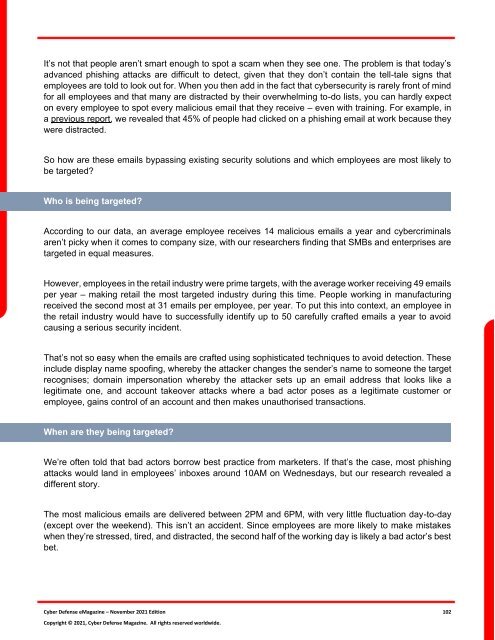Cyber Defense eMagazine November Edition for 2021
Cyber Defense eMagazine November Edition for 2021 #CDM #CYBERDEFENSEMAG @CyberDefenseMag by @Miliefsky a world-renowned cyber security expert and the Publisher of Cyber Defense Magazine as part of the Cyber Defense Media Group as well as Yan Ross, US Editor-in-Chief, Pieruligi Paganini, International Editor-in-Chief and many more writers, partners and supporters who make this an awesome publication! Thank you all and to our readers! OSINT ROCKS! #CDM #CDMG #OSINT #CYBERSECURITY #INFOSEC #BEST #PRACTICES #TIPS #TECHNIQUES See you at RSA Conference 2022 - Our 10th Year Anniversary - Our 10th Year @RSAC #RSACONFERENCE #USA - Thank you so much!!! - Team CDMG
Cyber Defense eMagazine November Edition for 2021 #CDM #CYBERDEFENSEMAG @CyberDefenseMag by @Miliefsky a world-renowned cyber security expert and the Publisher of Cyber Defense Magazine as part of the Cyber Defense Media Group as well as Yan Ross, US Editor-in-Chief, Pieruligi Paganini, International Editor-in-Chief and many more writers, partners and supporters who make this an awesome publication! Thank you all and to our readers! OSINT ROCKS! #CDM #CDMG #OSINT #CYBERSECURITY #INFOSEC #BEST #PRACTICES #TIPS #TECHNIQUES
See you at RSA Conference 2022 - Our 10th Year Anniversary - Our 10th Year @RSAC #RSACONFERENCE #USA - Thank you so much!!! - Team CDMG
You also want an ePaper? Increase the reach of your titles
YUMPU automatically turns print PDFs into web optimized ePapers that Google loves.
It’s not that people aren’t smart enough to spot a scam when they see one. The problem is that today’s<br />
advanced phishing attacks are difficult to detect, given that they don’t contain the tell-tale signs that<br />
employees are told to look out <strong>for</strong>. When you then add in the fact that cybersecurity is rarely front of mind<br />
<strong>for</strong> all employees and that many are distracted by their overwhelming to-do lists, you can hardly expect<br />
on every employee to spot every malicious email that they receive – even with training. For example, in<br />
a previous report, we revealed that 45% of people had clicked on a phishing email at work because they<br />
were distracted.<br />
So how are these emails bypassing existing security solutions and which employees are most likely to<br />
be targeted?<br />
Who is being targeted?<br />
According to our data, an average employee receives 14 malicious emails a year and cybercriminals<br />
aren’t picky when it comes to company size, with our researchers finding that SMBs and enterprises are<br />
targeted in equal measures.<br />
However, employees in the retail industry were prime targets, with the average worker receiving 49 emails<br />
per year – making retail the most targeted industry during this time. People working in manufacturing<br />
received the second most at 31 emails per employee, per year. To put this into context, an employee in<br />
the retail industry would have to successfully identify up to 50 carefully crafted emails a year to avoid<br />
causing a serious security incident.<br />
That’s not so easy when the emails are crafted using sophisticated techniques to avoid detection. These<br />
include display name spoofing, whereby the attacker changes the sender’s name to someone the target<br />
recognises; domain impersonation whereby the attacker sets up an email address that looks like a<br />
legitimate one, and account takeover attacks where a bad actor poses as a legitimate customer or<br />
employee, gains control of an account and then makes unauthorised transactions.<br />
When are they being targeted?<br />
We’re often told that bad actors borrow best practice from marketers. If that’s the case, most phishing<br />
attacks would land in employees’ inboxes around 10AM on Wednesdays, but our research revealed a<br />
different story.<br />
The most malicious emails are delivered between 2PM and 6PM, with very little fluctuation day-to-day<br />
(except over the weekend). This isn’t an accident. Since employees are more likely to make mistakes<br />
when they’re stressed, tired, and distracted, the second half of the working day is likely a bad actor’s best<br />
bet.<br />
<strong>Cyber</strong> <strong>Defense</strong> <strong>eMagazine</strong> – <strong>November</strong> <strong>2021</strong> <strong>Edition</strong> 102<br />
Copyright © <strong>2021</strong>, <strong>Cyber</strong> <strong>Defense</strong> Magazine. All rights reserved worldwide.


















